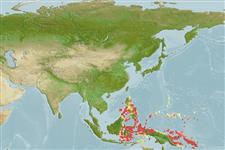>
Eupercaria/misc (Various families in series Eupercaria) >
Labridae (Wrasses) > Cheilininae
Etymology: Pseudocheilinops: Greek, pseudes = false + Greek, cheilos = lip + Greek, ops = appearance (Ref. 45335).
More on author: Schultz.
Environment: milieu / climate zone / depth range / distribution range
Écologie
marin récifal; profondeur 5 - 15 m (Ref. 90102). Tropical; 19°N - 8°S
Western Central Pacific: southern Philippines and Celebes (Indonesia) to Palau.
Taille / Poids / Âge
Maturity: Lm ? range ? - ? cm
Max length : 6.5 cm TL mâle / non sexé; (Ref. 48636)
Description synthétique
Clés d'identification | Morphologie | Morphométrie
Épines dorsales (Total) : 9; Rayons mous dorsaux (Total) : 11; Épines anales: 3; Rayons mous anaux: 9.
Mainly found in still coastal waters, where brittle corals grow high. Occurs in small groups that feed actively among the lower and dead parts of the corals with coralline algae. Easily overlooked because of its small size. Length to 6.5 cm, but usually much smaller (Ref. 48636). Always hides or stays close to its shelter (Ref. 90102). A secretive species. Feeds on amphipods and other small invertebrates. Rarely found in the aquarium trade.
Life cycle and mating behavior
Maturité | Reproduction | Frai | Œufs | Fécondité | Larves
Oviparous, distinct pairing during breeding (Ref. 205).
Westneat, M.W., 2001. Labridae. Wrasses, hogfishes, razorfishes, corises, tuskfishes. p. 3381-3467. In K.E. Carpenter and V. Niem (eds.) FAO species identification guide for fishery purposes. The living marine resources of the Western Central Pacific. Vol. 6. Bony fishes part 4 (Labridae to Latimeriidae), estuarine crocodiles. FAO, Rome. (Ref. 9823)
Statut dans la liste rouge de l'IUCN (Ref. 130435: Version 2024-1)
Menace pour l'homme
Harmless
Utilisations par l'homme
Pêcheries: sans intérêt
Outils
Articles particuliers
Télécharger en XML
Sources Internet
Estimates based on models
Preferred temperature (Ref.
123201): 28.5 - 29.4, mean 28.9 °C (based on 681 cells).
Phylogenetic diversity index (Ref.
82804): PD
50 = 1.0000 [Uniqueness, from 0.5 = low to 2.0 = high].
Bayesian length-weight: a=0.01585 (0.00700 - 0.03587), b=2.95 (2.76 - 3.14), in cm total length, based on LWR estimates for this (Sub)family-body shape (Ref.
93245).
Niveau trophique (Ref.
69278): 3.4 ±0.45 se; based on food items.
Résilience (Ref.
120179): Haut, temps minimum de doublement de population inférieur à 15 mois (Preliminary K or Fecundity.).
Fishing Vulnerability (Ref.
59153): Low vulnerability (10 of 100).
Nutrients (Ref.
124155): Calcium = 172 [97, 337] mg/100g; Iron = 1.04 [0.57, 2.01] mg/100g; Protein = 18.3 [15.4, 20.6] %; Omega3 = 0.166 [0.093, 0.292] g/100g; Selenium = 20.6 [10.4, 40.8] μg/100g; VitaminA = 165 [48, 681] μg/100g; Zinc = 2.5 [1.6, 4.0] mg/100g (wet weight);
